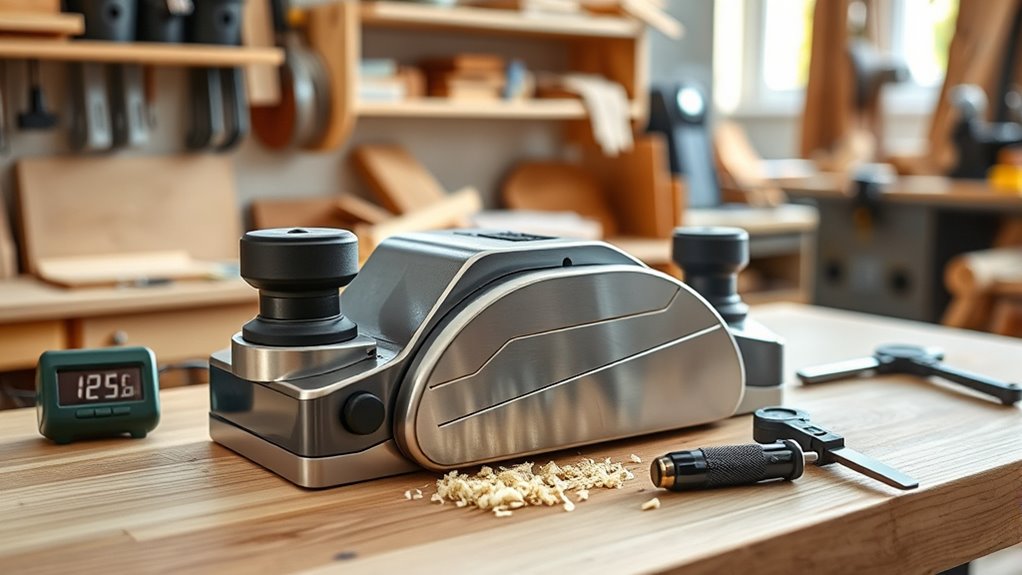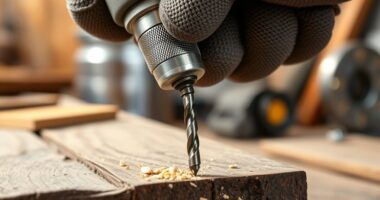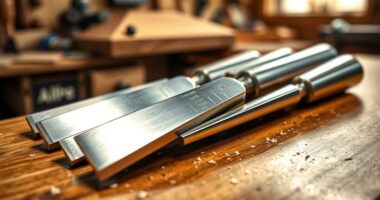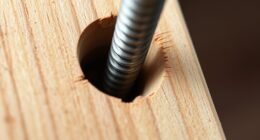Spending just 15 minutes daily on your planer can greatly extend its lifespan. Focus on inspecting and sharpening or replacing dull blades, removing dust and debris from vents and blades, and tightening any loose belts or screws. Don’t forget to lubricate moving parts to reduce wear and prevent rust. Maintaining this routine keeps your machine running smoothly, safe, and efficient. Keep going, and you’ll discover how these simple steps keep your planer in top shape longer.
Key Takeaways
- Spend 3-5 minutes inspecting and sharpening or replacing dull blades for cleaner cuts and less motor strain.
- Use compressed air or brushes to remove dust from vents, blades, and internal parts to improve airflow and cooling.
- Tighten loose belts and fasteners to prevent misalignment, vibrations, and uneven wear.
- Lubricate moving parts regularly to reduce rust, mechanical wear, and ensure smooth operation.
- Dedicate a few minutes daily to a routine of cleaning, inspection, and adjustments to extend your planer’s lifespan.
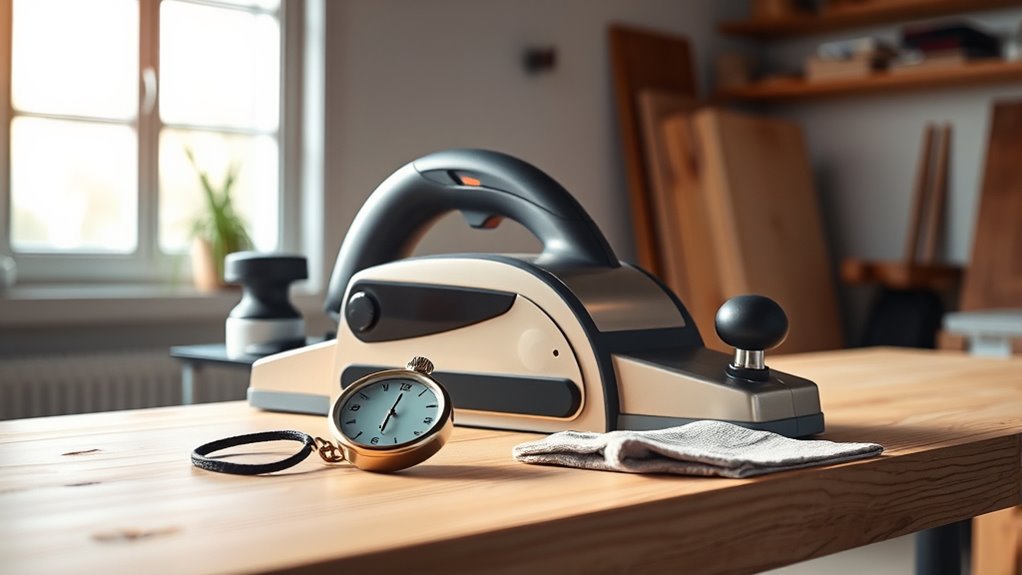
Maintaining your planer regularly can considerably extend its lifespan, and dedicating just 15 minutes a day can make a big difference. One of the most important aspects of this routine is blade maintenance. Sharp, well-maintained blades produce cleaner cuts, reduce strain on the motor, and help prevent uneven wear. Each day, start by inspecting your blades for nicks, dullness, or buildup of resin and debris. If you notice dull edges, sharpen or replace them promptly. Sharp blades cut more efficiently, which means less pressure on your machine, less heat buildup, and fewer chances of damage over time. Proper blade maintenance also minimizes kickbacks and ensures consistent results, saving you time and frustration in the long run.
Dust management is equally critical. Dust and wood shavings aren’t just messy; they can clog vents, impair motor function, and lead to premature breakdowns. Spend a few minutes each day clearing dust from around the planer’s vents, blades, and internal components. Use compressed air or a soft brush to gently remove debris from hard-to-reach areas. Keeping the dust under control improves airflow and cooling, reducing the risk of overheating and extending the lifespan of your machine. Regular dust management also creates a safer, cleaner workspace, helping you maintain focus and precision during your projects. Additionally, understanding the importance of color accuracy in your tools can lead to better quality in finished projects, especially when working with different materials.
In addition to blade maintenance and dust management, consider checking your planer’s belts and fasteners regularly. Loose belts or screws can cause misalignment, vibrations, and uneven cuts. Tighten or replace these components as needed to keep your machine running smoothly. Lubricating moving parts according to the manufacturer’s instructions helps prevent rust and reduces wear, which further prolongs your planer’s service life. These small, consistent efforts cumulatively make a significant difference.
Finally, develop a routine that suits your workflow. Dedicate a few minutes each day specifically to inspecting, cleaning, and adjusting your planer. Over time, this habit becomes second nature, ensuring your equipment stays in top shape without requiring extensive repairs or replacements. By focusing on blade maintenance and dust management daily, you safeguard your investment, improve your work quality, and enjoy your planer for years to come. Remember, a little effort each day yields long-term rewards—keeping your planer efficient, safe, and durable is well within reach with just 15 minutes of dedicated care.
Frequently Asked Questions
Can This Routine Be Adapted for Different Planer Models?
You wonder if this routine can be adapted for different planer models. The answer is yes, but you need to contemplate model compatibility and adjust maintenance steps accordingly. Different planers have unique features, so customize the routine to fit your specific machine. Focus on key maintenance tasks like blade sharpening and cleaning. By tailoring the routine, you’ll extend your planer’s lifespan regardless of the model you own.
How Often Should I Perform This Routine for Optimal Results?
To keep your planer running smoothly, you should follow a consistent maintenance schedule. For ideal frequency, perform this routine every 15 to 30 hours of use or once a month, whichever comes first. Regular upkeep prevents wear and extends your tool’s lifespan. Adjust the frequency based on how often you use your planer and the workload, but sticking to this schedule ensures excellent results and long-term performance.
Are There Specific Tools Recommended for Maintenance?
Perfectly maintaining your planer means mastering your maintenance checklist with the recommended tools. You’ll want a reliable screwdriver, a brush for debris, and lubricants suited for your machine. Using the right tools guarantees thorough cleaning and smooth operation, prolonging your planer’s life. Keep these recommended tools handy and follow your maintenance checklist regularly, so your planer performs perfectly and lasts longer, saving you time and trouble in the long run.
Does the Routine Require Professional Expertise or Can Beginners Do It?
You can definitely do DIY maintenance on your planer if you’re a beginner. The routine is designed to be beginner-friendly, so you don’t need professional expertise. With simple tools and clear instructions, you can perform regular checks and basic maintenance tasks easily. These beginner-friendly tips help extend your planer’s lifespan without any complicated procedures, making sure your tool stays in great shape with just a few minutes of your time.
What Are Common Mistakes to Avoid During the Routine?
Like steering a tightrope, avoiding common mistakes keeps your work balanced. You should focus on proper lubrication techniques, ensuring you don’t over-apply or skip them, which can harm your machine. Always follow safety precautions, like unplugging the planer before maintenance. Rushing through the routine or ignoring instructions leads to damage. Stay attentive, take your time, and double-check each step to protect your equipment and yourself.
Conclusion
By dedicating just 15 minutes each day to your planer’s routine, you’re fundamentally giving it a breath of fresh life—like a gardener tending to delicate plants. I once saw a craftsman extend his tool’s lifespan by treating it like a trusted friend, and it paid off with smoother cuts and fewer repairs. Remember, consistent care isn’t just maintenance; it’s your secret weapon to keep your tools running longer and working better, day after day.
